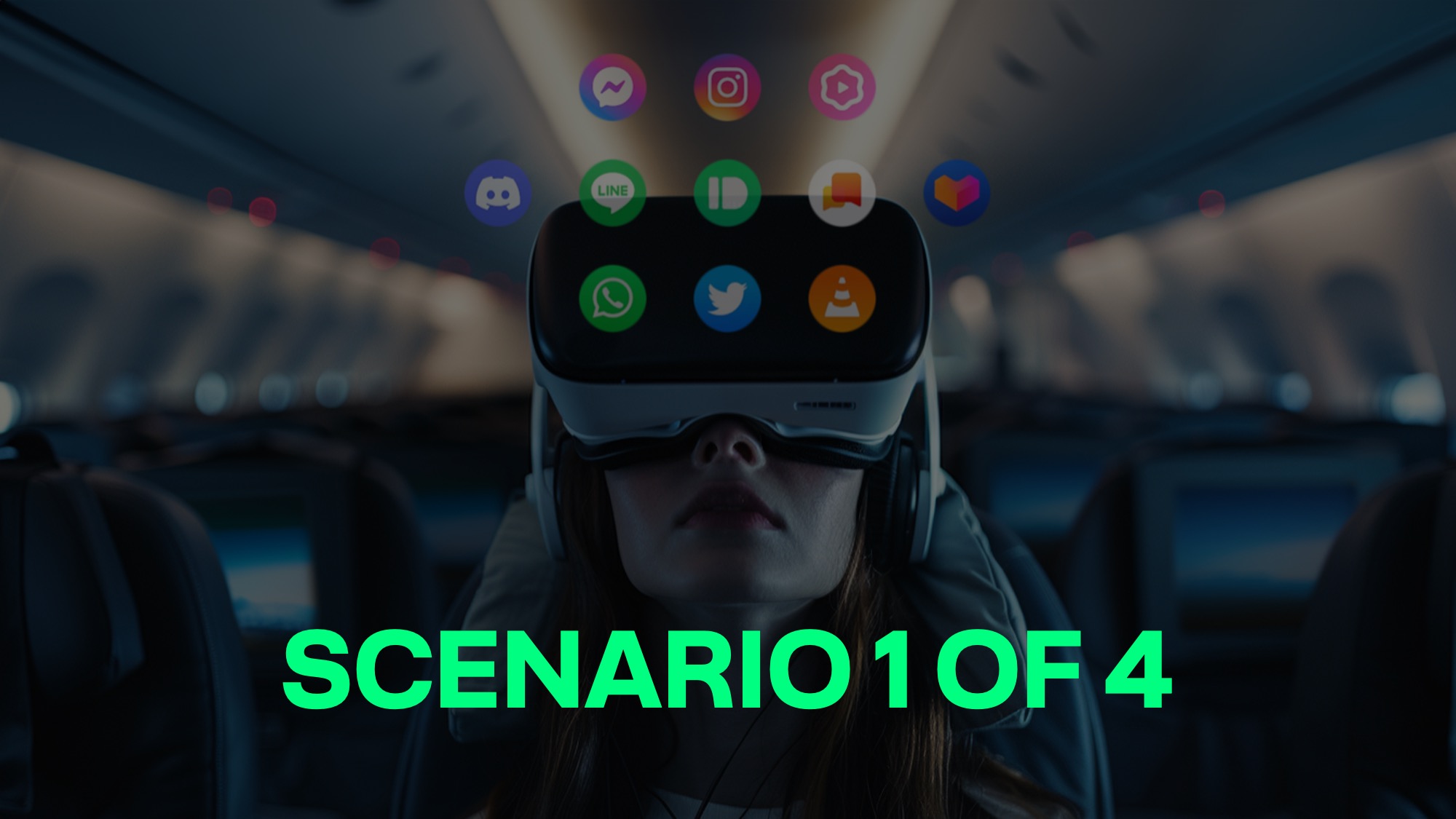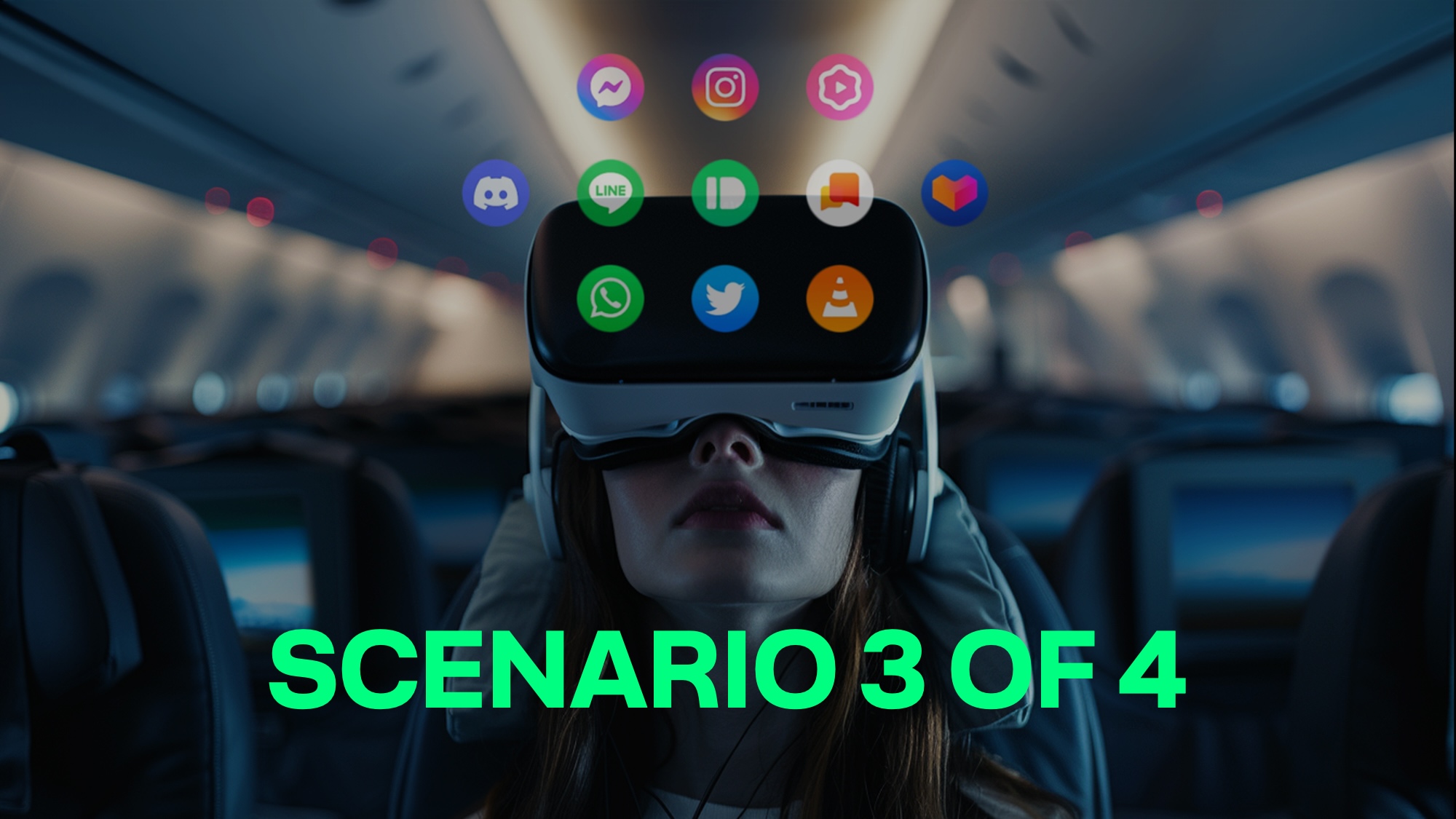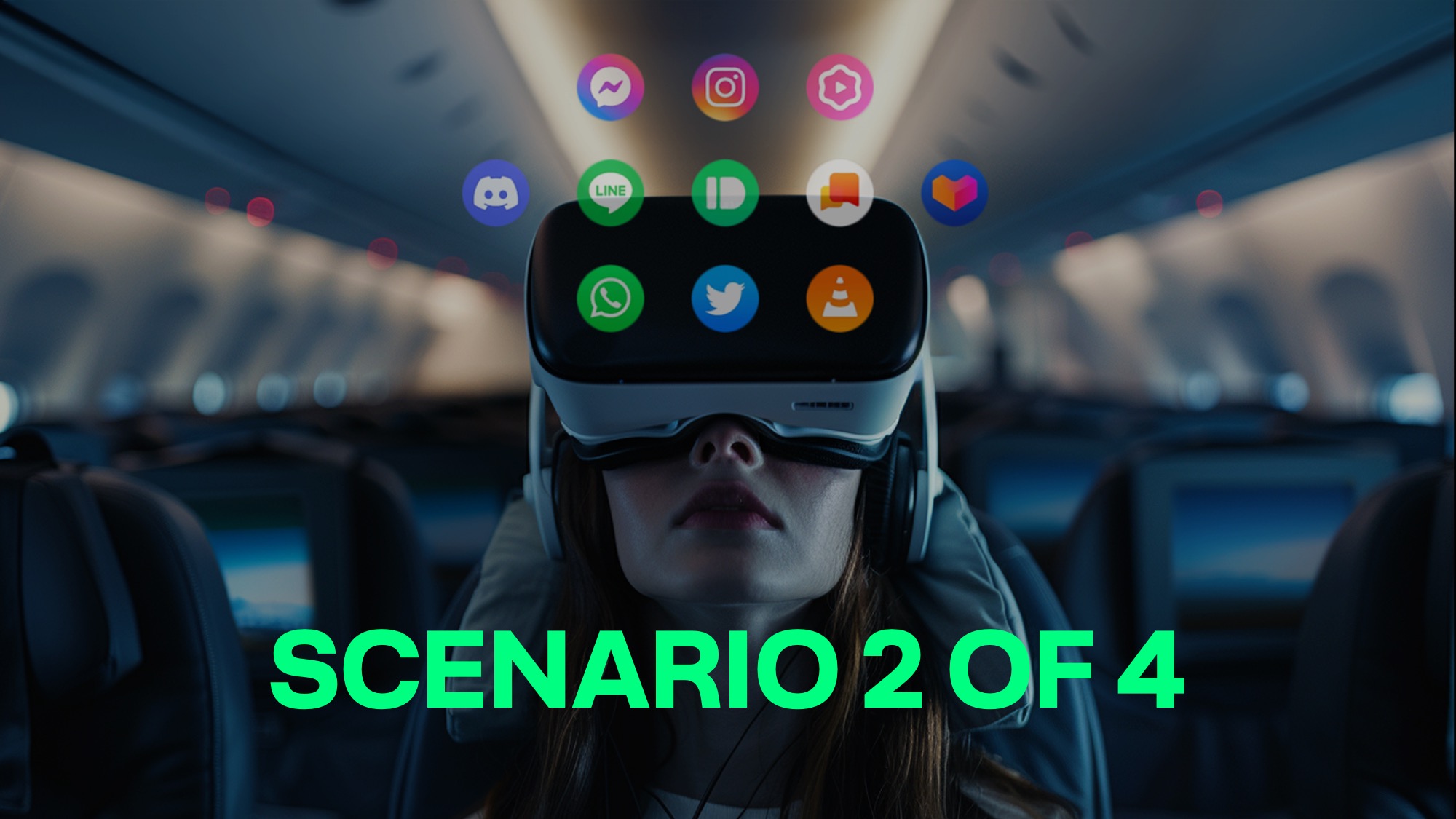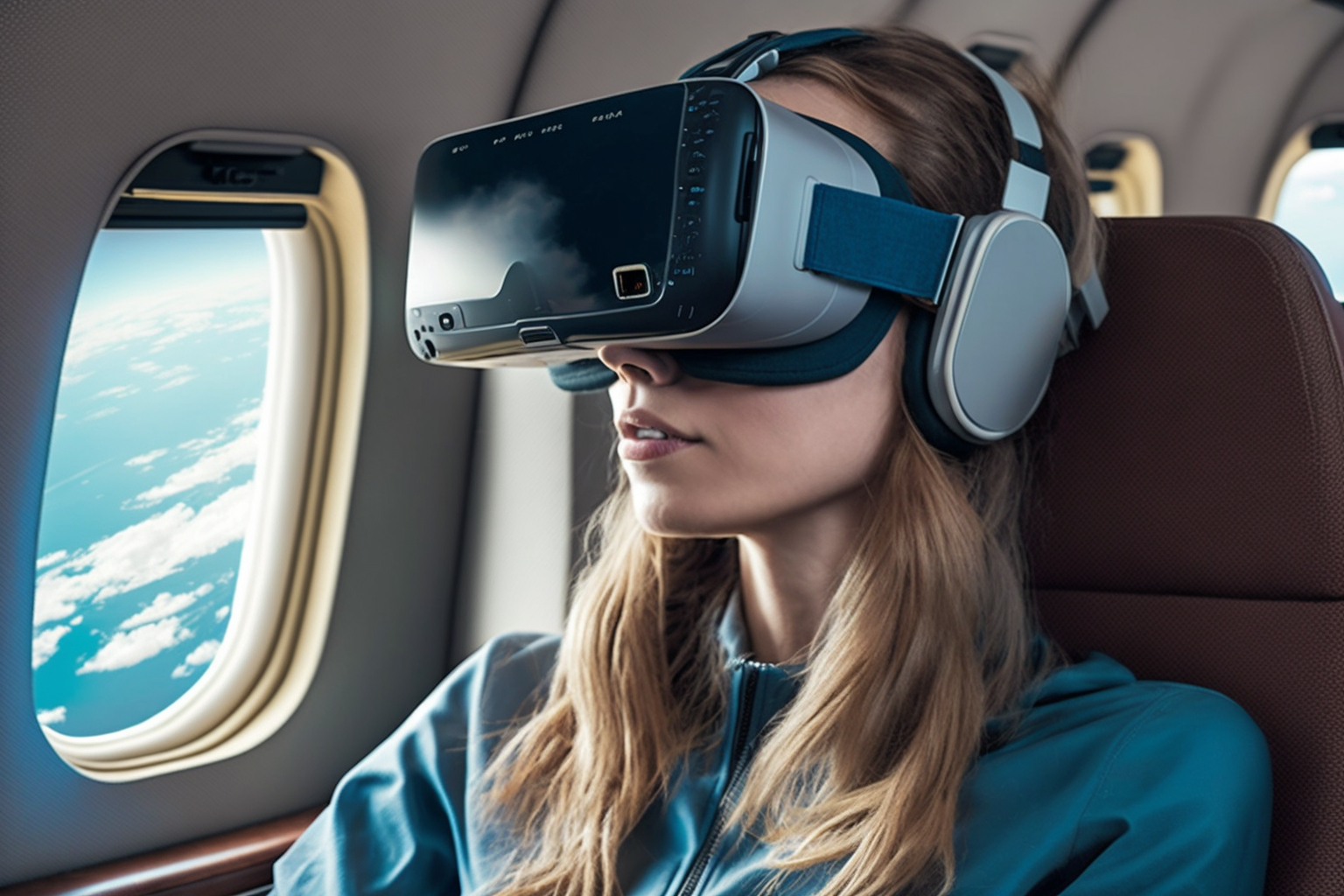In our recent exploration of the metaverse’s potential impact on the aviation industry, we embarked on an unconventional analysis, employing a “scenario-based approach” to envision the future integration of metaverse technologies within air travel.
Before we dive deeper, let’s briefly repeat what we mean by “metaverse”: It represents the convergence of our physical and virtual realities, powered by:
- Immersion: Utilizing immersive technologies such as Augmented Reality (AR), Virtual Reality (VR), and Mixed Reality (MR) alongside their corresponding devices, it crafts a hybrid reality that intertwines physical and digital dimensions.
- Ownership and Exchange of Digital Assets: The metaverse also enables the capability to possess and transact digital and virtual assets within these immersive spaces, facilitating a unique economy of virtual items and experiences.
Our collaborative effort, pooling insights from industry leaders at Airbus, Bauhaus Luftfahrt, and our team here at the Lufthansa Innovation Hub, has led us to formulate four distinct scenarios predicting the evolution of the metaverse in aviation over the next decade until 2035.
Each scenario is crafted to reflect varying degrees of consumer adoption and metaverse consolidation, setting the stage for a range of potential futures.
Focusing on “The Golden Islands”
Today, we zero in on the first scenario: “The Golden Islands.”
This scenario imagines a future in which consumer adoption of metaverse technologies remains relatively low and access to metaverse platforms is highly fragmented.
“The Golden Islands” scenario explores how this exclusive version of the metaverse might influence the aviation industry, providing unique opportunities for differentiation and premium services for airlines and other travel providers.

To explore this hypothetical future, let’s examine in more detail what characterizes the Golden Islands Scenario.
1. High Entry Costs Limiting Accessibility
In this scenario, the price of metaverse devices acts as a barrier to entry. Currently, the cost of these devices ranges significantly, with high-end options like Apple’s Vision Pro, the Vive Focus, and the Varjo VR series reaching thousands of dollars.
The technology behind these devices is often criticized for not delivering experiences that justify such costs. This scenario expects prices to rise in the short- to medium-term future, making these immersive devices even less accessible to the general consumer.
2. Specialization and Fragmentation
Such high costs of metaverse devices would serve as critical technology gatekeepers. As a result, the Golden Islands Scenario naturally caters to the wealthier portion of society. For them, high-end devices act as portals to exclusive metaverse experiences created and curated by luxury brands catering to wealthy consumers.
Thus, we assume the development of niche use cases targeted at high-net-worth individuals rather than widespread metaverse applications. This group’s interest in technology and luxury experiences makes them ideal metaverse users. With two-thirds of high-net-worth individuals saying AR/VR makes them more likely to buy luxury items, there’s a clear demand for unique, high-quality virtual shopping experiences.
Given the emphasis on exclusivity and customization in virtual luxury shopping, we expect metaverse platforms to be highly specialized and fragmented, designed to meet specific product and consumer preferences. This likely results in a metaverse landscape filled with separate, luxury-brand platforms competing for the attention of affluent users with promises of exclusivity and high-end virtual experiences.
So, in this scenario narrative, the metaverse emerges as a niche, luxury experience accessible only to those willing and able to invest in the high costs associated with immersive tech.
Metaverse meets Luxury: Parallels with NFTs
The potential trajectory of the metaverse towards luxury wouldn’t be all surprising when considering the path of closely related NFTs.
- NFTs made a significant splash in the luxury consumer segment right from the outset.
- Recall the moment that catapulted NFTs into the media spotlight: digital artist Beeple’s sale of “Everydays: The First 5000 Days” for a jaw-dropping $69 million through Christie’s, a high-profile auction house.
This connection between NFTs and the luxury market has persisted. Even as NFTs no longer strike the astronomical prices of their early days, luxury brands across various sectors, including travel, have continued to explore NFTs and virtual experiences.
Examples of NFTs in the Luxury Space include:
- In 2022, luxury giants like Louis Vuitton, Burberry, Balenciaga, and Gucci all delved into metaverse explorations with NFTs and virtual shopping initiatives.
- Premium luggage brand Rimowa released a limited-edition series of luggage design NFTs.
- In a more recent move in June 2023, Louis Vuitton launched a series of NFTs featuring its iconic travel trunks, with starting prices reported to be around €39,000.
- The airline industry has also started to incorporate NFTs as part of their premium offerings. Rumors in 2022 suggested American Airlines included an NFT in its exclusive gifts for Concierge Key members.
These examples highlight how luxury brands, including those in the travel sector, are not just experimenting with NFTs but are integrating them into their high-end offerings. This trend suggests that if the metaverse does shift towards a luxury-oriented path, it wouldn’t be an unprecedented shift but rather a continuation of the luxury segment’s ongoing engagement with virtual innovations connected to exclusive experiences.
Implications for Future Aviation
Considering aviation’s track record in deprioritizing the (digital) customer experience, airlines may not be the first to develop sophisticated metaverse use cases. However, we expect airlines to be followers once the technology is advanced enough to be adopted in other industries.
Particularly premium carriers would find themselves positioned as relatively quick followers, keen on developing consumer-facing applications tailored for the high-end traveler segment.
Why?
- The premium travel segment’s importance to airlines cannot be understated. During a recent investor day, American Airlines CCO Vasu Raja stated that around 80% of the airline’s 2024 revenue will be driven by its frequent-flier program and premium products.
- The substantial contribution of premium products to overall profitability and customer loyalty has prompted a number of airlines to explore partnerships with luxury brands.
- Our exploration of the parallels between airlines and luxury brands underscored the expanding luxury consumer base, which is projected to grow from approximately 400 million individuals in 2022 to 500 million by 2030.
This anticipated growth underscores the importance of travel brands catering to this demographic, a trend that’s already shaping airline offerings today.
- Airlines are increasingly focusing on enhancing the premium travel experience, from upgrading premium seating to adopting service innovations that cater to the needs and preferences of high-net-worth individuals.
- Companies like Scenset and Brevity, which specialize in luxury travel planning, signal the broader “luxification of travel,” catering to the expectations of affluent travelers.
This evolving landscape suggests airlines may soon venture into innovative territories, bridging the physical and digital realms to cater to the premium market’s evolving expectations.
To make this all more concrete, let’s delve into two specific outlooks that could define how this future unfolds for the airline industry.
1. Metaverse Use Cases in Luxury Air Travel
As metaverse technologies mature and intersect with the desires of luxury consumers, airlines are poised to deploy a suite of metaverse-enabled innovations. These advancements aim to redefine the high-end travel experience, offering unparalleled levels of immersion, personalization, and convenience.
Here’s a closer look at the potential innovations airlines might embrace to cater to the high-end market:
- Immersive Pre-Flight Planning: Imagine premium passengers having the ability to virtually step into their destination, explore luxurious accommodations, or select their seats in an immersive pre-flight environment. This level of engagement would not only enhance the booking experience but also solidify customer loyalty by appealing directly to the luxury consumer’s desire for exclusivity and personalization.
- Exclusive In-Flight Experiences: By integrating high-end immersive devices, airlines could offer unparalleled in-flight entertainment options, ranging from virtual destination tours to relaxation programs designed for the premium traveler. This approach could redefine in-flight service standards, offering a unique value proposition that elevates the brand in the luxury travel space.
- Immersive Concierge Service: Real-time virtual assistance could guide travelers through their journey, from navigating busy airport terminals to reach their lounges and to guiding people along the multi-modal transport journey up until their final hotel destination, offering ad-hoc support and enhancing the travel experience with convenience and personalization.
- Innovative Loyalty Rewards with VR: Virtual reality could revolutionize airline loyalty programs, offering rewards that go beyond traditional perks. Exclusive virtual events, VR experiences reflecting travel destinations, or tokenized collectibles linked to travel achievements could become coveted rewards, enhancing the value of loyalty programs for high-net-worth individuals.

2. Geographic leaders of Luxury Metaverse Experiences
It’s crucial to not only define potential use cases but also identify the regions poised to spearhead the adoption of digital assets and immersive experiences. Our analysis, considering the intersection of digital savviness and wealth concentration, reveals key areas where luxury metaverse trends could flourish.
In Asia, cities like Hong Kong and Singapore emerge as focal points, housing a significant population of affluent individuals. Notably, these cities are among the top global locales for millionaire residents, as highlighted by Henley & Partners.
- But the wealth in these regions isn’t just static; it’s dynamically engaged with the digital ecosystem.
- A 2022 KPMG survey revealed a strong inclination towards digital assets among high-net-worth individuals (HNWIs) and family offices in these cities, with 58% investing in digital assets and 60% of these investors exploring NFTs and metaverse ventures.
The Middle East, with hubs like Dubai and Riyadh, mirrors this trend, complemented by rising wealth centers in Abu Dhabi and Doha. The UAE, in particular, is establishing itself as a frontrunner in the cryptocurrency and digital assets space, underscored by the creation of the Virtual Asset Regulatory Authority.
- The region’s enthusiasm for crypto is tangible, with a 2023 PwC survey indicating significant cryptocurrency ownership among retail investors in the UAE (30%) and Saudi Arabia (23%).
- This enthusiasm extends into the metaverse. Noteworthy initiatives include Saudi Arabia’s “National Cultural Metaverse Platform” for virtual reality tours and the country’s partnership with Animoca Brands to drive Web3 innovations.
All these efforts signify a regional commitment to integrating metaverse technologies into the fabric of travel and cultural exploration driven by the concentration of wealthy, digitally savvy consumers.
Envisioning The Next Decade: The Golden Islands Scenario Unfolds
As we conclude our exploration of the “Golden Islands” scenario, we recognize the metaverse’s transformative potential within the luxury aviation sector.
This future envisions a closer integration between luxury and aviation industries, opening entirely new avenues for premium travel experiences.
However, this isn’t the only potential path forward.
We’ve explored three other scenarios, each offering a distinct perspective on the emergence of the metaverse in aviation.
Stay tuned for our ongoing series as we continue to delve into these alternative futures.










